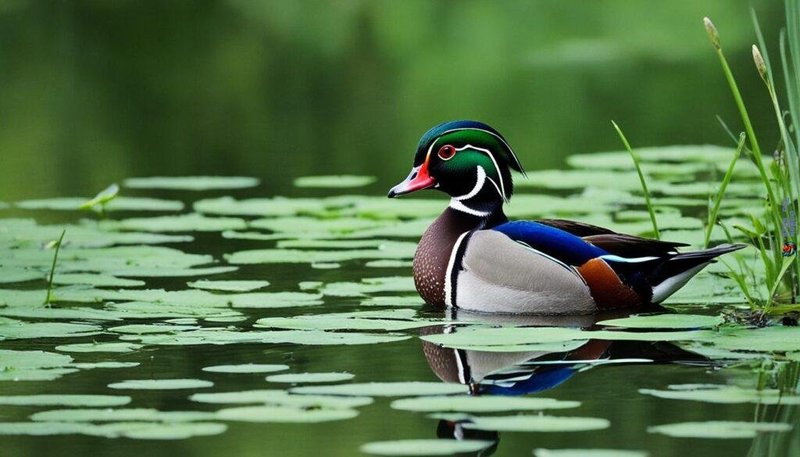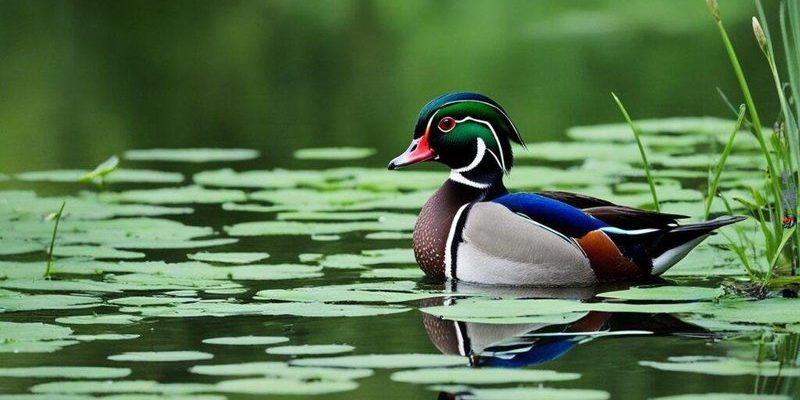
The wood duck, scientifically known as *Aix sponsa*, is not just a pretty face; it has a fascinating story of survival and evolution. From its remarkable nesting habits to its colorful appearance, the wood duck captures the hearts of bird lovers and casual observers alike. So, what exactly makes this species so special? Let’s dive into its history and discover how it has changed and adapted over the years.
The History of the Wood Duck’s Evolution
The wood duck has a lineage that dates back millions of years. It belongs to the family Anatidae, which includes all ducks, geese, and swans. The earliest ancestors of ducks started appearing in the fossil record over 50 million years ago. These ancient birds set the stage for the evolution of many modern species, including the wood duck.
Over time, wood ducks have developed traits that allow them to thrive in diverse habitats. They are unique among ducks because they can perch on trees, thanks to their strong, clawed feet. This ability may have evolved to help them escape predators and search for nesting sites away from the water. The wood duck’s preference for wooded swamps, marshes, and rivers also shaped its evolution, allowing it to adapt to a more arboreal lifestyle compared to other waterfowl.
Interestingly, wood ducks are known for their stunning mating displays. During the breeding season, males flaunt their vibrant plumage to attract females. This elaborate courtship ritual is not just for show; it plays a crucial role in their reproduction and survival. Here’s the thing: the bright colors of the males signal their health and vitality, making them more appealing to potential mates.
Physical Characteristics of Wood Ducks
One of the first things you’ll notice about wood ducks is how beautiful they are. Males are adorned with striking green and purple head plumage, bright red eyes, and a distinctive white throat patch. In contrast, females have a more subtle beauty with grayish-brown feathers and a white facial patch. This difference in appearance isn’t just for aesthetics; it serves an important purpose in their survival.
The vibrant colors of male wood ducks may attract mates, but they can also make them more visible to predators. Females, with their more muted tones, blend into their environment, making them less noticeable, especially while nesting. This sexual dimorphism ensures that both sexes have their own advantages in the wild.
Another fascinating feature of the wood duck is its unique feet. Unlike most ducks that are built for diving or dabbling, wood ducks have strong, clawed feet that allow them to perch on branches. This adaptation helps them escape potential threats, as they can quickly fly up and away from danger. Their versatility in moving between water and land sets them apart from many of their relatives.
Nesting Habits and Behavior
When it comes to nesting, wood ducks are truly one-of-a-kind. Unlike many ducks that nest on the ground, wood ducks prefer to nest in tree cavities, often abandoned by other animals. This unusual choice helps protect their eggs and ducklings from land predators. In fact, a study found that about 68% of wood duck nests are located in tree cavities, showcasing the bird’s unique adaptation to its environment.
Here’s a quick peek into their nesting behavior: female wood ducks usually select a cavity that is 3 to 20 feet above the ground. After laying their eggs, they will incubate them for about 30 days. Once the ducklings hatch, they leap from the tree and make their way to the water—a risky but instinctual journey that showcases their strong survival instincts.
Interestingly, wood duck mothers show incredible dedication. After the hatchlings leave the nest, they lead them to water and teach them essential life skills, like foraging for food. This nurturing behavior is crucial for the ducklings’ survival, as they must quickly learn how to find food and avoid predators.
The Impact of Habitat Loss and Conservation Efforts
Despite their adaptability, wood ducks face challenges due to habitat loss. Urban development, logging, and wetland drainage have led to a decline in their natural habitats. Fortunately, conservation efforts have been underway to help protect and restore these environments. Many organizations focus on creating suitable habitats for wood ducks, recognizing the importance of wetlands not just for this species but for countless other plants and animals.
Wood ducks are also unique in their ability to thrive in both rural and urban settings. They can be found in parks and gardens, making them a wonderful sight for city dwellers. Municipalities that invest in habitat restoration and protection are contributing significantly to the wood duck population’s recovery.
Nesting boxes have also been introduced as a conservation strategy. These artificial cavities provide safe nesting options for wood ducks, helping to improve their breeding success. Many local wildlife organizations run programs to install and monitor these boxes, allowing communities to actively participate in protecting these beautiful birds.
Wood Ducks in Culture and Recreation
Wood ducks have carved a niche in our culture and recreational activities. Birdwatchers and nature enthusiasts often seek them out for their beauty and unique behaviors. Their striking appearance has made them popular subjects in photography and art, inspiring many to appreciate wildlife and the importance of conservation.
Hunting also plays a role in the relationship between humans and wood ducks. Regulated hunting seasons exist to manage their population and ensure sustainable practices. It’s important to note that these regulations are in place to protect the species and their habitats while allowing for responsible hunting.
You might also find wood ducks featured in local folklore and stories. Their colorful presence in wetlands and parks has made them symbols of beauty and resilience, inspiring people to connect with nature and advocate for environmental conservation.
The journey of the wood duck from its ancestral roots to its current status as a beloved and resilient bird is a testament to the power of adaptation. Its striking appearance, unique nesting habits, and strong survival instincts highlight how interconnected this species is with its environment. As we continue to face challenges like habitat loss, our role in conservation can make a difference.
By understanding and appreciating the wood duck, we can advocate for the protection of its habitats and promote a healthier ecosystem. So the next time you spot a wood duck paddling gracefully across the water or perched high in a tree, take a moment to admire its beauty and the rich history that surrounds it. Let’s celebrate this remarkable bird and work together to ensure its legacy for future generations.

